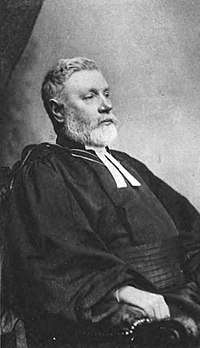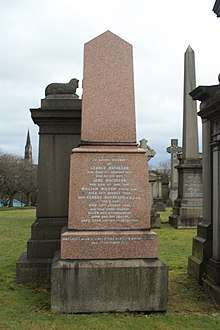George Matheson
Rev Dr George Matheson DD FRSE (27 March 1842 – 28 August 1906) was a Scottish minister and hymn writer. He was blind from his youth.[1]

Life

Born at 39 Abbotsford Place in Glasgow, to George Matheson (d.1891), a merchant and Jane Matheson (a second cousin), he was the eldest of eight children.
He was educated at Glasgow Academy and the University of Glasgow, where he graduated first in classics, logic and philosophy. In his twentieth year he became totally blind, but he held to his resolve to enter the ministry, and gave himself to theological and historical study. In 1879 the University of Edinburgh conferred upon him the honorary degree of D.D.. In 1890, he became a fellow of the Royal Society of Edinburgh, upon the proposal of Sir William Thomson, Robert Flint, Hugh Macmillan and James Lindsay.
He died suddenly of apoplexy (stroke) at Avenell House in North Berwick on 28 August 1906 in Edinburgh and is buried with his parents in the Glasgow Necropolis. The grave lies near the summit.
He never married.[2]
Service
He started as an assistant pastor in 1866. His first ministry began in 1868 at Innellan, on the Argyll coast between Dunoon and Toward. He stayed 18 years. His books on Aids to the Study of German Theology, Can the Old Faith live with the New?, The Growth of the Spirit of Christianity from the First Century to the Dawn of the Lutheran Era, established his reputation as a liberal and spiritually minded theologian; and Queen Victoria invited him to preach at Balmoral. She had his sermon on Job published.
In 1886, he moved to Edinburgh, where he became minister of St. Bernard's Parish Church in Stockbridge for 13 years. Here his chief work as a preacher was done.
In 1879, he declined an invitation to the pastorate of Crown Court, London, in succession to Dr. John Gumming (1807–1881). In 1881 he was chosen as Baird lecturer, and took for his subject Natural Elements of Revealed Theology, and in 1882 he was the St Giles lecturer, his subject being Confucianism. In 1890 he was elected a fellow of the Royal Society of Edinburgh, the University of Aberdeen gave him its honorary LL.D., and in 1899 he was appointed Gifford lecturer by that university, but declined on grounds of health. In the same year he severed his active connection with St. Bernard's.
Published works
One of his hymns, "O Love That Wilt Not Let Me Go," has passed into the popular hymnology of the Christian Church. Matheson himself wrote of the composition:
- "I am quite sure that the whole work was completed in five minutes, and equally sure that it never received at my hands any retouching or correction. I have no natural gift of rhythm. All the other verses I have ever written are manufactured articles; this came like a dayspring from on high." [3]
"O Love That Wilt Not Let Me Go" was written on the evening of Matheson’s sister’s marriage. Years before, he had been engaged, until his fiancée learned that he was going blind—that there was nothing the doctors could do—and she told him that she could not go through life with a blind man. He went blind while studying for the ministry, and his sister had been the one to care for him through the years, but now she was gone. He was now 40, and his sister’s marriage brought a fresh reminder of his own heartbreak. It was in the midst of this circumstance and intense sadness that the Lord gave Matheson this hymn, which he said was written in five minutes.
Matheson published only one volume of verse, Sacred Songs.[4] All of which he commented 'I simply followed the impression of the moment' [5] His exegesis owes its interest to his subjective resources rather than to breadth of learning; his power lay in spiritual vision rather than balanced judgment, and in the vivid apprehension of the factors which make the Christian personality, rather than in constructive doctrinal statement. His other writings[6] include :
- Can the Old Faith Live with the New
- The Distinctive Message of the Old Religions
- The Psalmist & The Scientist
- Spiritual Development of St Paul
- Times of Retirement
- The Voice of the Spirit
Notes
- Biographical Index of Former Fellows of the Royal Society of Edinburgh 1783–2002 (PDF). The Royal Society of Edinburgh. July 2006. ISBN 0 902 198 84 X.
- Lindsay, Rev. James (5 November 1906). "Rev. George Matheson, D.D., LL.D., F.R.S.E." Proceedings of the Royal Society of Edinburgh. 26 (1): 550–551. doi:10.1017/S0370164600024792.
- O Love That Wilt Not Let Me Go at the Cyber Hymnal Archived 11 April 2010 at the Wayback Machine
- Matheson, George, Sacred Songs, W M Blackwood & Sons London kindle ebook ASIN B008UC9ER0
- Preface to Matheson, George, Sacred Songs, W M Blackwood & Sons London kindle ebook ASIN B008UC9ER0
- Further reading per index to Sacred Songs, W M Blackwood & Sons London kindle ebook ASIN B008UC9ER0
References
![]()
Bailey, Albert Edward (1950). The Gospel in Hymns. New York: Charles Scribner's sons. pp. 457–461.
Julian, John (June 1907). A Dictionary of Hymnology. London: John Murray.
Cyber Hymnal. "George Matheson". Archived from the original on 11 April 2010. Retrieved 18 February 2010.
Brady, Gary. "Bio 05 George Matheson". Retrieved 18 February 2007.